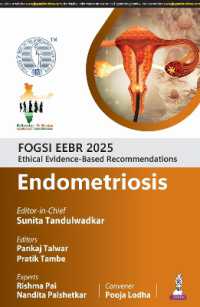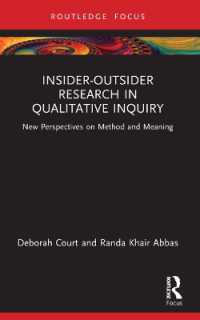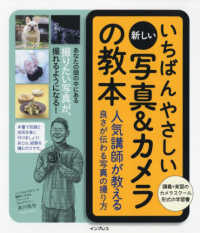- ホーム
- > 洋書
- > 英文書
- > Science / Mathematics
Full Description
Research Methods in Physical Activity, Seventh Edition, systematically guides students through the research process, introducing methods and tools specifically for kinesiology and exercise science disciplines, including the subdisciplines of physical therapy, rehabilitation, and occupational therapy. The seventh edition leads students and novice researchers to research competency with the distinctive humor that has become a trademark of this internationally recognized text.
This text provides step-by-step information for every aspect of the research process, from identifying and devising research questions to analyzing data and compiling results for presentation. Methods for qualitative, quantitative, and mixed-methods research approaches are addressed, and real-world research questions—including historical, experimental, epidemiological, and philosophical—are presented by scholarly contributors who give suggestions for approaches to follow. Photos, anecdotes, and humorous stories are used throughout the text to put students at ease and emphasize key points through practical applications. Enhancements to the seventh edition include the following:
• Updated information and techniques for electronic searches to ensure students use best research practices
• New information on meta-analysis and the benefits of journal-style writing that teach readers to evaluate and prepare data for scholarly journals and publication
• Special attention to ethical issues to help readers understand the regulations involved in using human and animal subjects
• New information on logistic regression that aids in the understanding of complex ideas
• Further explanation of qualitative and mixed-methods research approaches, in addition to quantitative approaches, to ensure readers use the most appropriate methodology for their research
The content of the seventh edition maintains and expands upon the logical content progression that has made Research Methods in Physical Activity the leading text in the field.
Part I presents an overview of the research process, including problem development, preparation of the research plan, and understanding ethical issues in research and writing. Part II introduces statistical and measurement issues in research, and part III presents various types of or approaches to research and methodology from expert researchers in the field. Part IV includes a writing guide for result findings and details how to develop and organize research papers and presentations. Statistical tables and guides are available in the appendix.
To aid instructors, Research Methods in Physical Activity, Seventh Edition, includes a suite of ancillary materials featuring an instructor guide, test package, an extra data set for instructors who wish to create specialized learning activities, and presentation package plus image bank.
Research Methods in Physical Activity, Seventh Edition, instills in students the confidence to devise, collect, analyze, and present their research in a competent manner by systematically guiding them through the research process. It is an essential text for all emerging researchers in physical activity.
Contents
Part I: Overview of the Research Process
Chapter 1. Introduction to Research in Physical Activity
The Nature of Research
Unscientific Versus Scientific Methods of Problem Solving
Alternative Models of Research
Types of Research
Overview of the Research Process
Parts of a Thesis: A Reflection on the Steps in the Research Process
Summary
Chapter 2. Developing the Problem and Using the Literature
Identifying the Research Problem
Purpose of the Literature Review
Basic Literature Search Strategies
Steps in the Literature Search
Summary
Chapter 3. Presenting the Problem
Choosing the Title
Writing the Introduction
Stating the Research Problem
Presenting the Research Hypothesis
Operationally Defining Terms
Basic Assumptions, Delimitations, and Limitations
Justifying the Significance of the Study
Differences Between the Thesis and the Research Article
Summary
Chapter 4. Formulating the Method
How to Present Methodological Details
Why Planning the Method Is Important
Two Principles for Planning Experiments
Describing Participants
Describing Instruments
Describing Procedures
Describing Design and Analysis
Establishing Cause and Effect
Interaction of Participants, Measurements, and Treatments
Summary
Chapter 5. Ethical Issues in Research and Scholarship
Seven Areas of Scientific Dishonesty
Ethical Issues Regarding Copyright
Model for Considering Scientific Misconduct
Working With Faculty
Protecting Human Participants
Protecting Animal Subjects
Summary
Part II: Statistical and Measurement Concepts in Research
Chapter 6. Becoming Acquainted With Statistical Concepts
Why We Need Statistics
Use of Computers in Statistical Analysis
Description and Inference Are Not Statistical Techniques
Ways to Select a Sample
Justifying Post Hoc Explanations
Difficulty of Random Sampling and Assignment: How Good Does It Have to Be?
Unit of Analysis
Measures of Central Tendency and Variability
Basic Concepts of Statistical Techniques
Data for Use in the Remaining Statistical Chapters
Summary
Chapter 7. Statistical Issues in Research Planning and Evaluation
Probability
Meaningfulness (Effect Size)
Power
Using Information in the Context of the Study
Summary
Chapter 8. Relationships Among Variables
What Correlational Research Investigates
Understanding the Nature of Correlation
What the Coefficient of Correlation Means
Using Correlation for Prediction
Partial Correlation
Uses of Semipartial Correlation
Procedures for Multiple Regression
Logistic Regression
Discriminant Function AnalysisMultivariate Forms of Correlation
Summary
Chapter 9. Differences Among Groups
How Statistics Test Differences
Types of t Tests
Interpreting t
Relationship of t and r
Analysis of Variance
Analysis of Covariance
Experimentwise Error Rate
Understanding Multivariate Techniques
Summary
Chapter 10. Nonparametric Techniques
Chi Square: Testing the Observed Versus the Expected
Procedures for Rank-Order Data
Correlation
Differences Among Groups
Summary
Chapter 11. Measuring Research Variables
Validity
Reliability
Methods of Establishing Reliability
Intertester Reliability (Objectivity)
Standard Error of Measurement
Using Standard Scores to Compare Performance
Measuring Movement
Measuring Written Responses
Measuring Affective Behavior
Scales for Measuring Affective Behavior
Measuring Knowledge
Item Response Theory
Summary
Part III: Types of Research
Chapter 12. Sociohistorical Process in Sport Studies
David K. Wiggins and Daniel S. Mason
Development of the Discipline Theory and Sport History
Relationship Between Theory and Method
Research Goals and Questions
Research Topics
Research Design
Data Analysis and Interpretation
Research Findings
Exemplary Studies in Sport History
Summary
Chapter 13. Philosophical Research in Physical Activity
R. Scott Kretchmar and Tim Elcombe
Identifying the Purposes of Philosophical Research
Identifying the Range of Philosophical Research
Locating a Research Problem
Analyzing a Research Problem
Summary
Chapter 14. Research Synthesis (Meta-Analysis)
Using Meta-Analysis to Synthesize Research
Presenting Effect Size Data
Summary
Chapter 15. Surveys
Questionnaires
Electronic Surveys
Delphi Method
Personal Interviews
Normative Surveys
Summary
Chapter 16. Other Descriptive Research Methods
Developmental Research
Case Studies
Job Analysis
Observational Research
Unobtrusive Research Techniques
Correlational Research
Summary
Chapter 17. Physical Activity Epidemiology Research
Barbara E. Ainsworth and Charles E. Matthews
Observational Versus Experimental Research
What Is Epidemiology?
Physical Activity Measurement Definitions
Assessment of Physical Activity
Epidemiological Study Designs
Reading and Interpreting a Physical Activity Epidemiological Study
Summary
Chapter 18. Experimental and Quasi-Experimental Research
Sources of Invalidity
Threats to Internal Validity
Threats to External Validity
Controlling Threats to Internal Validity
Controlling Threats to External Validity
Types of Designs
Summary
Chapter 19. Qualitative Research
Procedures in Qualitative Research
Analysis of the Data
Concluding Remarks
Summary
Chapter 20. Mixed-Methods Research
Combining Quantitative and Qualitative Methods
Designing Mixed-Methods Research
Issues in Mixed-Methods Research
Examples of Mixed-Methods Research
Summary
Part IV: Writing the Research Report
Chapter 21. Completing the Research Process
Research Proposal
Thesis and Dissertation Proposal
Advisor and Dissertation Committee
The Good Scholar Must Research and Write
Scientific Writing
First Things Are Sometimes Best Done Last
Developing a Good Introduction
Describing the Method
The Proposal Process
Preparing and Presenting Qualitative Research Proposals
Writing Proposals for Granting Agencies
Submitting Internal Proposals
Completing Your Thesis or Dissertation
Results and Discussion
Handling Multiple Experiments in a Single Report
Using Tables and Figures
Summary
Chapter 22. Ways of Reporting Research
Basic Writing Guidelines
A Brief Word About Acknowledgments
Thesis and Dissertation Format: Traditional Versus Journal
Helpful Hints for Successful Journal Writing
Revising Research Papers
Writing Abstracts
Making Oral and Poster Presentations
Summary








